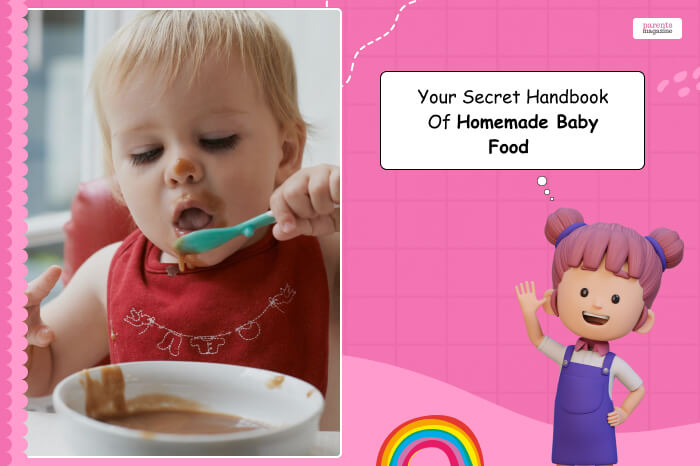
Your Secret Handbook Of Homemade Baby Food
Till the first six months of the baby’s birth, breastfeeding is exclusively recommended. After that, you can give them solid food but do not wean them off breast milk at once. For any first-time parent, it is difficult to figure out what type of baby food you should give.
It is best to consult a pediatrician to know the best time to introduce them to solid food. So, when you have the “go ahead” from your doctor about solid foods, it is time to think of some homemade baby food for the little one.
Some parents want to give their children organic baby food. Here are some ideas to help you make a healthy meal for your baby while monitoring if they are getting any food reactions.
Essential Tools For Preparing Homemade Baby Food
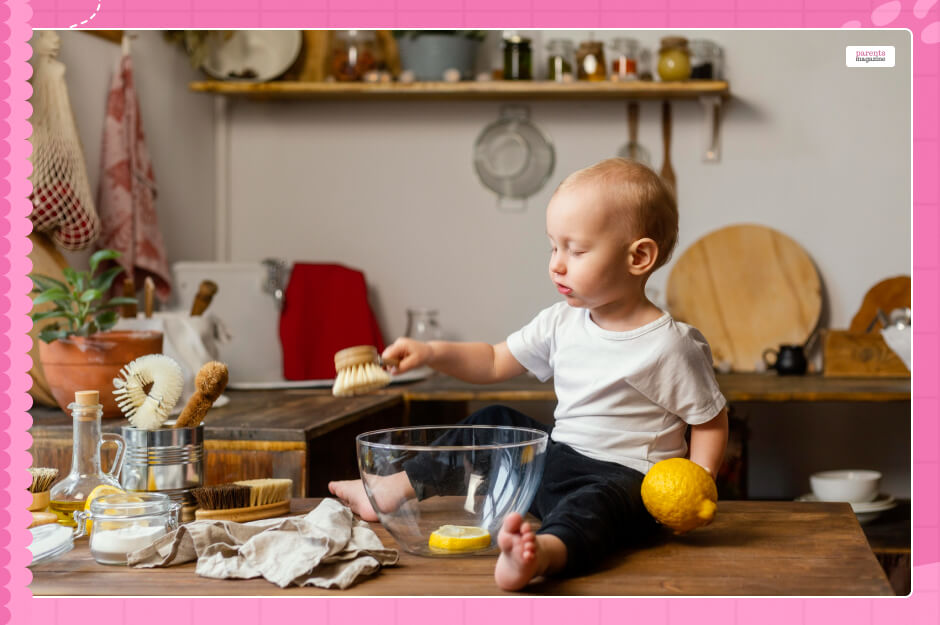
To prepare homemade baby food, you are going to need some tools. Here are the essential ones mentioned to get you through the process.
- Blender
- Formula, water, or breast milk
- Knife
- Bowls
- Spoon
- Ice cube tray
- Freezer bags
- Storage containers
Getting Started with Homemade Baby Food
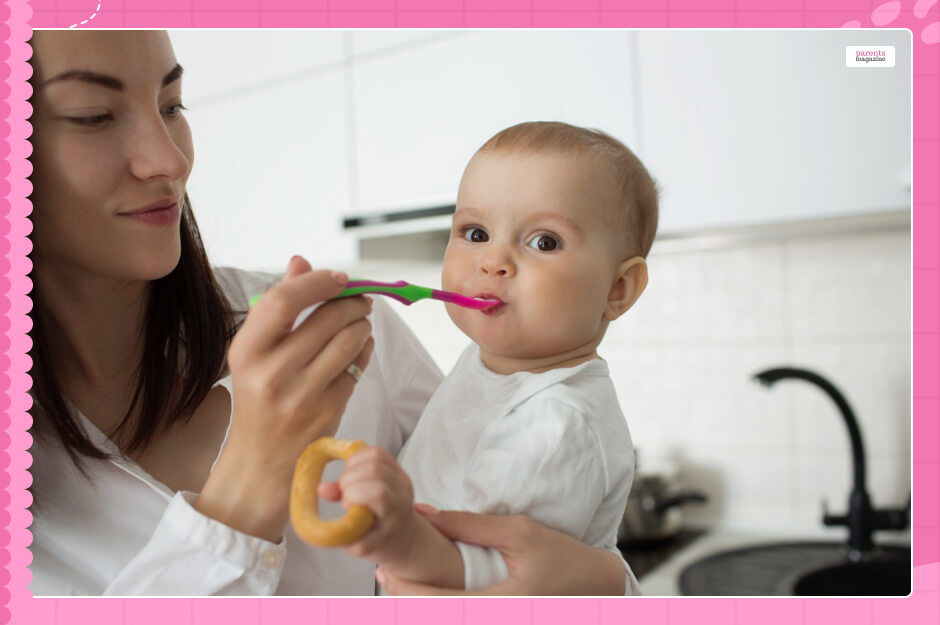
If you are thinking of preparing homemade food for your baby, but can’t think of anything, you can start with a few homemade items. You can start by mashing a banana or an avocado.
If you like it, then you can continue with food that is rich in nutrients. However, make sure that you are not introducing a lot of new items at a time, and mash their food properly, so they do not choke on it.
Make homemade baby from items that are in season or pick items from the meal that you are preparing for the entire family. Remember not to add salt, sugar, or any kind of seasonings to their food.
Step-by-Step Guide to Preparing Homemade Baby Food
DIY baby food needs extra caution, and you have to endure sanitation. Scrub and wash the fruit or vegetables you are preparing for the little one and keep all the tools and utensils clean where you are preparing. Here is how you should begin.
- Clean the item thoroughly and remove seeds if there are any. Fruits or vegetables are are grown underground or close to the ground need special attention, because of harmful bacteria. They can cause food poisoning.
- Cook food until it is tender. Steaming, microwaving, and pressure cooking with a little bit of water are beneficial as they retail the vitamins and minerals. If you are giving them fish or meat, remove all their skin and bones before cooking.
- Baby puree recipes are the ones you should start with. If your child is less than 12 months of age, do not add honey to any of their food. Do not add any sweeteners to their food.
- Ensure that the temperature and the texture of the food are appropriate for them. It can make them choke. If you have pureed their food, make it thin if needed.
- Moreover, when you are cooking, meats and eggs, cook them very well. Maintain the temperature. For fish, beef, and pork, it should be 145 degrees Fahrenheit. 160 for egg and ground beef, and 165 for poultry and chicken.
Homemade Baby Food Recipes by Age
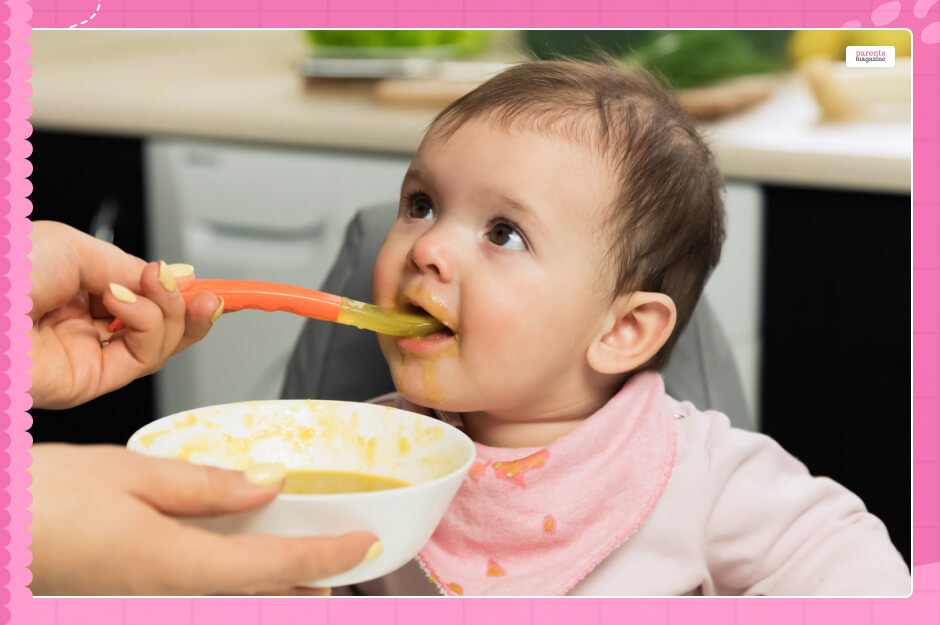
Preparing homemade baby food has different stages. You have to prepare them something depending on their age and food habits. If you are thinking of how to make baby food, here are some of the best and easiest recipes for you.
4–6 Months (First Foods)
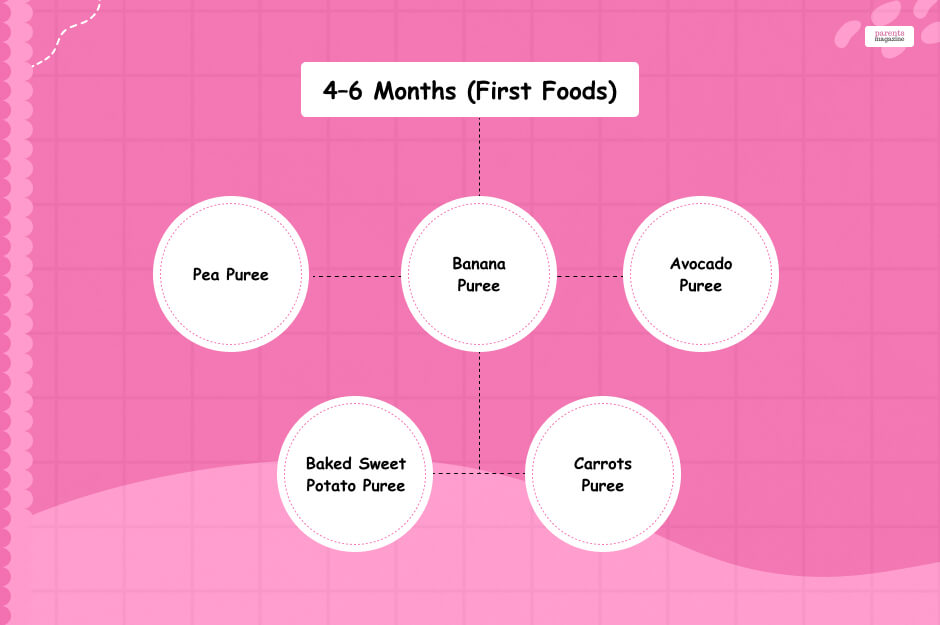
In this stage, there is not much to experiment with. You will have to go with simple and single-ingredient purees. So, here are some of the best baby food puree recipes.
Pea Puree
Peas are packed with nutritional values. They have vitamins A & C, and they are also rich in calcium, iron, and protein. Here is how you will prepare it.
Step 1: To begin with, boil the water, and add the peas. Cook it for 15 minutes.
Step 2: Add the boiled peas and breast milk in a blender, and puree it. Strain the mixture to remove all the lumps.
Step 3: Put the puree in an ice tray, cover it with plastic and freeze it. Once they freeze, take it out and store it in the freezer in resealable plastic bags.
Step 4: Before serving, heat the cubes in a microwave. It won’t take more than 30 seconds. Stir it thoroughly and serve it.
Banana Puree
Bananas are rich in fiber and potassium. They are natural antacids and one of the best first foods. This is an amazing baby puree recipe for your baby, do not feed them too many bananas, or it can cause constipation.
Step 1: Peel the skin and put the banana in a blender.
Step 2: If this seems too thick, dilute it with breast milk and serve it.
Avocado Puree
Avocado is a low-allergenic food and contains a lot of healthy fats. This is very good for their physical and brain development.
Step 1: Cut open the avocado. Take the pit out and scoop the flesh.
Step 2: You can mash the avocado with the help of a fork or put the scooped flesh in a blender. If you are putting it in a blender, make a good amount at one time.
Step 3: You can dilute the puree with water, formula, or breast milk to get the consistency you want.
Step 4: For later use, freeze the puree in an ice tray, and once done, keep it in a resealable plastic and keep it in the freezer.
Step 5: Thaw it before you plan to serve it to your baby.
Baked Sweet Potato Puree
Sweet potatoes are rich in fiber, vitamins, and antioxidants. This makes an amazing meal for your baby while maintaining all the nutritional values.
Step 1: Preheat the oven to 200 degrees Celsius. Put the sweet potatoes in a tray and bake for 45 to 60 minutes.
Step 2: Let it cool and then take the peel off.
Step 3: Put the sweet potatoes in a blender or food processor until it is smooth.
Step 4: If you want, you can pass it through a sieve to remove any remaining lumps and serve.
Step 5: Put the puree in an ice tray, cover it with plastic and freeze it. Once they freeze, take it out and store it in the freezer in resealable plastic bags.
Step 6: Before serving, heat the cubes in a microwave. It won’t take more than 30 seconds.
Carrots Puree
This is something you should give your baby when you want to make a transition to solid food. They are rich in vitamin A and the antioxidant beta-carotene.
Step 1: Peel the carrots and chop them into small chunks.
Step 2: You can steam, boil, or roast the carrots.
Step 3: Transfer the carrots to a food processor or blender.
Step 4: Blend till the puree gets smooth, then add some breast milk or water to dilute the puree. You can also use a formula.
Step 5: Serve it in small portions and store it in ice cubes and containers for use later.
Step 6: You can store it in the refrigerator for 3 days or 30 days in a freezer.
6–8 Months (Introducing Textures)
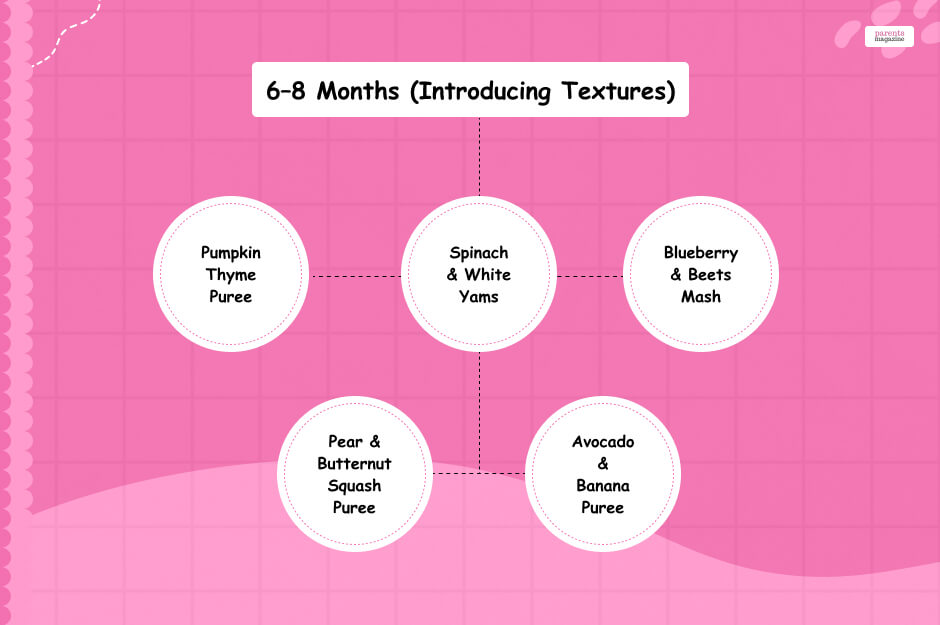
You can give 6-8-month-old babies thicker purees and add multiple ingredients to it. However, do not introduce them to multiple new ingredients all at once.
Pumpkin Thyme Puree
This is a seasonal recipe and is rich in iron, potassium, and beta-carotene. Prepare a big portion and freeze it in cubes for single-portion servings later.
Step 1: Preheat the oven and prepare a baking sheet.
Step 2: Chop the pumpkin into small pieces and set them on the baking sheet, with the skin side down.
Step 3: Roast the pumpkin until it is tender.
Step 4: Cool it down and peel the skin.
Step 5: Blend the pumpkin in a blender and add thyme to it. Add water or breast milk in small quantities to get the desired consistency. You can serve it immediately or freeze it for later.
Spinach & White Yams
This combination gets your baby a good dose of folate, iron, calcium, and vitamin A. Moreover, yams add sweetness to the goodness of greens.
Step 1: To half a pound of spinach add half a pound of white yams.
Step 2: Wash the spinach and peel the yams in small pieces.
Step 3: Boil the yams in half a cup of water or sodium-free vegetable stock. After that bring it to a simmer and cook it for ten more minutes. Then add the spinach and cook till both get tender.
Step 4: Get it cool and then make a puree out of it in a blender.
Step 5: Serve it or store it in a freezer for later use.
Blueberry & Beets Mash
If your baby loves colorful things, this is something they are going to be fascinated by. Not only does it create a beautiful color, but it is also rich in fiber, vitamins, and antioxidants.
Step 1: Wash the blueberries and peel the beets to start with.
Step 2: Steam both ingredients together for about ten to fifteen minutes.
Step 3: Put the whole thing in a blender and make a puree out of it.
Step 4: You can add water or breastmilk to make a beautiful consistency.
Step 5: Serve it, or you can store it in a freezer for almost three months.
Pear & Butternut Squash Puree
Butternut squash is one of the safest ingredients, as it rarely causes allergies. Moreover, adding pear gives a hint of sweetness to it.
Step 1: Peel the butternut squash, remove the seeds, and chop it into small pieces.
Step 2: Steam it for ten to twelve minutes.
Step 3: Peel and chop the pear.
Step 4: Add it to the butternut squash and cool everything together till tender.
Step 5: Put it in a blender and add breast milk or water to get to your desired consistency.
Step 6: Serve it, or you can store it in a freezer for almost three months.
Avocado & Banana Puree
When you mix these two things, you get a food that is rich in fiber and good fats that come from the avocados and vitamin C and potassium that comes from the bananas. Mixing the bananas adds a little bit of sweetness to the dense pure.
Step 1: Cut the avocado, peel the pit, and scoop the meat with a spoon. Peel the bananas as well.
Step 2: Put everything together and blend it in a food processor or blender.
Step 3: Strain the puree to remove the lumps and get a smooth texture.
Step 4: Pour it into individual serving containers and refrigerate for three to four days or freeze it for almost a month.
Step 5: Thaw it before you plan to give it to your baby if you freeze it.
8–12 Months (Finger Foods and Advanced Purees)
At this age, babies can have chunkier mashes. You can add dairy, if they are not allergic to it, like yogurt or cheese. Here are some of the recipes you can try at this stage.
Apricot & Banana With Cinnamon
This recipe has a hint of spiciness because of the addition of cinnamon. If you want, you can also add a little bit of cooked oatmeal or cereal to it. Here is the recipe given.
Step 1: Boil the water and add some oatmeal to it. Boil it for some time, and then let it rest in the water for the next 20 to 30 minutes.
Step 2: Pur apricots in boiling water and soak them for ten to twenty minutes.
Step 3: Add the oatmeal, banana, and soaked apricot in the blender.
Step 4: Add a little bit of cinnamon powder to the puree and serve it to your baby.
Carrot, Leek & White Fish Puree
If you are introducing different flavors to your baby, this recipe is a blockbuster. Whitefish has omega-3 fatty acids and helps in the development of the central nervous system. Carrots are filled with anti- oxidants and leeks help with cardiovascular activities.
Step 1: You can use cod, sea bass, tilapia, or halibut as your choice of fish. Clean it properly.
Step 2: Bake the fish, poach it, or broil it and keep it aside.
Step 3: Steam or bake the leek and carrots.
Step 4: Put everything together in a blender and your wholesome homemade baby food is ready.
Quinoa Banana Mash
Quinoa is rich in protein and if your baby is not yet ready to consume meat and other forms of protein, then this is a good alternative. Moreover, this adds a texture to the mashed bananas. Here is how you can prepare it.
Step 1: Take a tablespoon of quinoa and steam it for ten minutes. It might take longer to cook, so check it and cook accordingly.
Step 2: Then add the steamed quinoa and a banana in a blender.
Step 3: Your homemade baby food is ready.
Cherry & Mint Greek Yogurt
The cherry puree adds a lot of flavor to the yogurt base. Ensure that you take full-fat yogurt. Here is the recipe given.
Step 1: Take a little bit of homemade yogurt.
Step 2: Puree some cherry and mint together, and add it to your yogurt.
Step 3: You can add the amount of fruit puree you need to get the desired taste. However, make sure not to add any sugar.
Step 4: Give it a good mix, and you are ready to serve.
Creamy Provencal chicken
This recipe includes Herbes de Provence which is a combination of spices that will allow your child to taste new flavors. However, there is no salt in it.
Step 1: Take chicken breasts and cut them into two pieces.
Step 2: Cook the chicken breasts for five to six minutes and then keep them aside.
Step 3: Add broth to it and some Herbes de Provence.
Step 4: Bring it to a boil and then add the chicken breasts to it.
Step 5: Puree everything together. Add some cream or cheese to it in the blender and it is ready.
Meal Planning and Batch Cooking
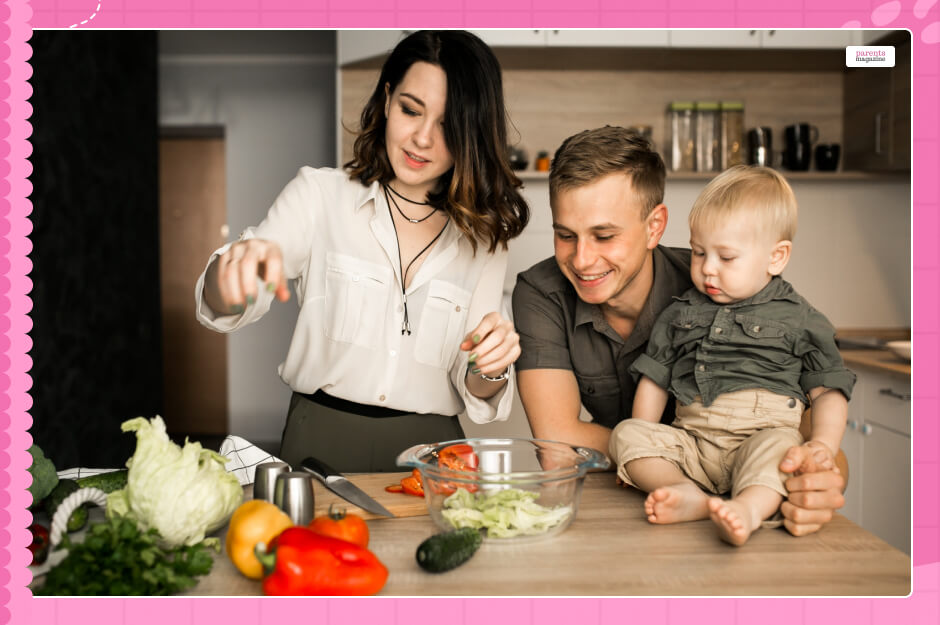
While planning meals for your baby, you must prepare a list of baby food ingredients that you will need, how you will prepare them, and how you will store them. Decide when you will give them protein, and when you will give them vegetables, fruits, and cereals.
When you are preparing homemade baby food, you have to be extra cautious to make sure it is safe for your baby and has all the nutritional values. After you are done with the preparation, either serve it or refrigerate it immediately.
Prepare stews, soups, and purees in large quantities. Before you put it in an airtight container, make sure you have cooled the soup. Storing it in small containers is beneficial because it will be easy to thaw.
Keep it in a covered container for a day or two or you can freeze it for a month or two. However, remember to label it with the date. You can serve it in separate dishes and small portions. This is ideal because you have to throw out any food that you served, and they did not finish.
Expert Tips for Successful Homemade Baby Food
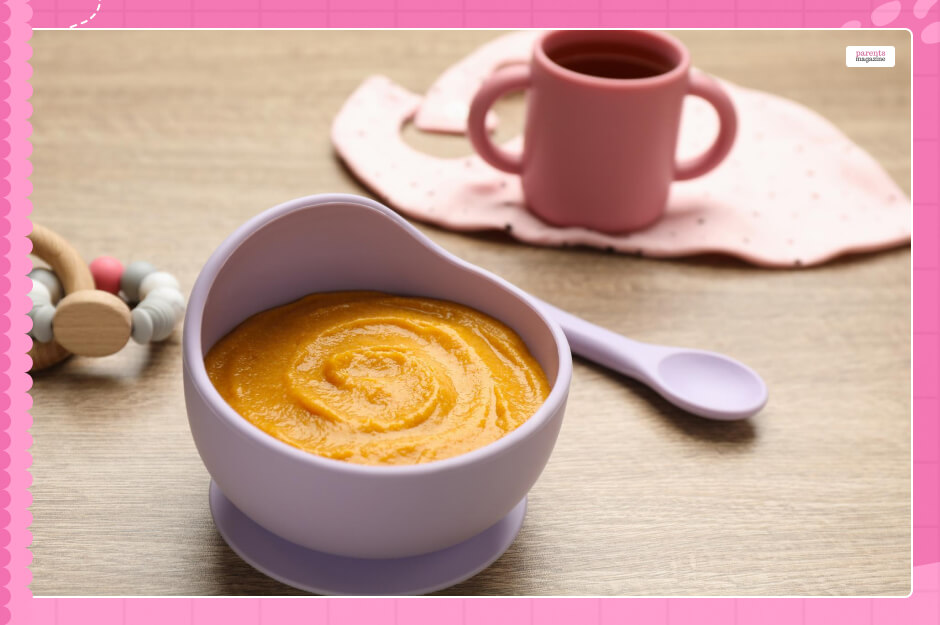
Preparing homemade baby food is no joke. There are a lot of things that you have to take care of. Here are some of the tips to ensure your success.
- Take one cup of the base ingredient to make sure the blender has a good volume to blend well.
- Make the homemade puree thin with breast milk, water, or formula.
- Use an ice cube tray to free the food which you will not use in the next three days. You can then keep the frozen cubes in storage bags for almost three months. Before giving it to your baby, thaw it in an air-tight container.
- Before making a puree, taste the fresh foods, to ensure they have enough sweetness. To mellow down the tartness, you can combine it with sweet potato, apple puree, banana puree, or avocado puree.
- You can combine two different purees, to make a complex flavor for them.
- If they are old enough, you can add a little bit of texture to their food like hemp seeds and baby oatmeal.
Conclusion
Even if it seems complex in the beginning, you will get the hang of it in a few days. All you need is fresh ingredients, some tools and supplies, and a blender or food processor to get it done. Preparing homemade baby food is not as difficult as you might think.
You cannot compromise on the safety part of it. So, make sure you clean and prepare everything cautiously. And you will find various high-quality storage supplies in the market.
Already have an account?
Sign In
Create your account
User added successfully. Log in








